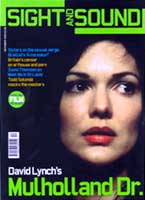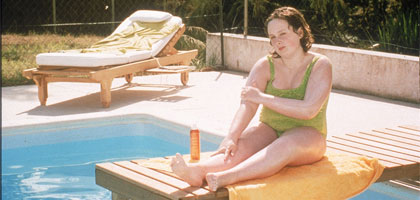
Sisters, Sex And Sitcom

The two sisters on the sexual brink in À ma soeur! are powerfully realised, but what do they look forward to, asks Ginette Vincendeau.
Editor's note: This feature necessarily gives away the film's shock ending.
There is a by now well-documented recent tendency in French auteur cinema to explore themes of sex through scenarios whose explicitness verges on the pornographic. Catherine Breillat, along with Patrice Chéreau (Intimacy, 2001), Léos Carax (Pola X, 1999) and Virginie Despentes and Coralie Trinh Thi (Baise-moi, 2000), is a leader of the trend. Her 1999 film Romance was billed as the most explicit heterosexual art film to date. Sexual and cerebral, violent and controversial, her work sets out to provoke. She doesn't altogether escape accusations of sensationalism (as when she cast porn star Rocco Siffredi in Romance) and there have been claims of a sexual escalation aimed at attracting the attention of festivals and critics with more nudity, more erections, more violence and more outré sexual practices.
À ma soeur! eschews the high-profile sado-masochism of Romance to return to apparently more mundane concerns. The central dynamic of the film is the relationship between two teenage sisters: conventionally plain, fat 12-year-old Anaïs (Anaïs Reboux) and slim, gorgeous 15-year-old Elena (Roxane Mesquida). The girls have a typical siblings' love-hate relationship - one moment insulting each other, the next ganging up on their parents and giggling helplessly at private jokes. Whereas in her 36 fillette (1988) Breillat combined in 14-year-old Lili (Delphine Zentout) an adolescent's awkwardness and burgeoning sex appeal, here these traits are split between À ma soeur!'s two central characters. This allows the film to engage with contemporary feminist concerns about body image. Breillat's filming of the overweight Anaïs is both flatly realistic and sympathetic, demonstrating the director's sensitivity to the outrageous anxieties provoked by our culture's idealisation of a particular body image, incarnated here by Elena.
But À ma soeur! is no cute teen pic where girls worry about weight, dates and make-up, and Breillat quickly cuts to the heart of the matter: sexuality. On two separate occasions Elena and her holiday romance Fernando (Libero de Rienzo) have sex while Anaïs watches. On the first night Elena refuses to yield her virginity and after much petting and discussion agrees to anal sex; on the second Fernando wins his campaign and has 'normal' intercourse with her. There is much fumbling and two brief shots of Fernando's erect penis; Elena also gives him oral sex in the open air.
Linda Ruth Williams (S&S July 2001) suggested that a spoof porn-film title for Baise-moi could be 'Thelma and Louise Get Laid'. In the same vein, À ma soeur! could be retitled 'One Fucks, the Other Watches'. Yet the film itself forestalls voyeurism. When radical Italian chanteuse and actress Laura Betti (who plays Fernando's mother) appears on television in a 60s interview watched by the two sisters and claims that her show 'is about the sexual question, not about sex', Anaïs' voiced approval hints we can take this as Breillat's aim too.
Breillat's approach to the sex scenes in À ma soeur! is in line with the 'real-time sex' on show in the new slate of films, a strategy she pioneered in 36 fillette. Feminists have long argued that the 'male gaze' in classical cinema is achieved in part through the fragmentation of women's bodies, and in À ma soeur! Breillat eschews such images. The slow pace of the scenes, their dispassionate style and brutal precision disengage us, refuting eroticism. But the most important way Breillat distances us from the action is through Anaïs' gaze, which mediates the seduction and ultimate humiliation of her sister.
The lengthy first sex scene (25 minutes of screen time) and the second shorter one (just over 5 minutes) are shot either from Anaïs' bed looking at her sister's, or from behind Elena's bed with Anaïs visible or suggested in the background. The camera is firmly on Anaïs' face as Fernando penetrates Elena anally, and we hear with her Elena's cries and Fernando's grunts. In the second scene Fernando and Elena's legs are visible in the background while the foreground is occupied by Anaïs in close-up, turned towards us and crying. Her gaze makes us uneasy for two reasons. First, she reminds us we are intruding on an intimate scene, and second, we are aware that she is too young to be witnessing this. A recurrent motif in the film (including the very first and last images) is Anaïs' accusing stare at the camera. Her deadpan comments about sex, love and virginity balance Elena's naive romanticism, but they are still somehow too adult. So her stated wish to divorce sex from love ('The first time, I'd like it to be a man I don't love') strikes us less as the defiance of a 12-year-old than as the director's often reiterated position on the question.
Breillat's excruciating portrayal of adolescent sex is accompanied by a merciless critique of male romantic discourse and machismo. Fernando's single-minded pursuit of vaginal penetration is conducted through sugary Latin-lover babble. He tries to clinch the deal with such phrases as 'It would be a proof of love' and after telling Elena how he humiliated another woman, insists, 'But I'll respect you.' The younger but wiser Anaïs and the audience watch as Elena falls for this hackneyed male flattery just as she later buys his offer of an engagement ring alleged to be a family heirloom but in fact stolen from his mother. The juxtaposition of graphic physicality, shot using Breillat's trademark long takes, and the verbal language of sentimental romans-photos (or sitcom, as Breillat puts it) demonstrates that these very different expressions of heterosexual relationships both oppress women. When Elena shows Anaïs the ring and states that she will now 'give herself to him', Anaïs retorts, 'What kind of vocabulary is this?' Her cynicism reveals both the crude bargain her sister can't see - a ring for a 'proper' fuck - and the bankruptcy of such sentimental language.
As in her other films, Breillat explores with great lucidity the traps involved for women in conventional notions of heterosexual sexuality and femininity. Where cinema is full of loveable and/or horribly fascinating cads (from My Fair Lady to Naked) and where a postmodern film like Neil LaBute's In the Company of Men exposes male tricks but gives us no access to the woman's perspective, À ma soeur! shows us the effects of dishonest male seduction techniques from a woman's point of view and highlights the double standards in operation. As Breillat has said, 'The older girl is neither more frivolous nor more stupid than her sister, but she cannot understand that she is only an object of desire. And as such she can only be taken. Or had.' By contrast Anaïs is in the tradition of Breillat's strong women, refusing to be a victim of male abuse in any shape or form.
Yet À ma soeur! is no feminist tract and we should know better than to expect a politically correct analysis from a director who enjoys cultivating an iconoclastic image. In 36 fillette a 14-year-old girl is shown flirting heavily with a 40-year-old man. I remember the outrage of the audience at the 1988 Norwich women's film weekend, who inaccurately accused Breillat of suggesting the young girl provoked rape. In Perfect Love! (Parfait Amour!, 1996) the heroine is raped and killed after taunting her lover. In Romance the protagonist seemingly welcomes abusive sexual encounters and describes the bliss of being a 'gaping hole'.
In À ma soeur! Anaïs' earlier expressed preference for first-time sex without love is horrifically fulfilled in the film's bloody climax in which Elena and their mother are brutally murdered by a man who breaks into their car while they are asleep in a motorway lay-by, with Anaïs, again, watching unblinkingly from the back seat. She gets out of the car and is raped by the man in the woods, though she later denies this to the policeman who finds her. Of course such appalling acts of violence are committed by men against women on an almost daily basis, but the constant reiteration in Breillat's cinema of such events, together with her ubiquitous dysfunctional families and the absence of any pleasure - sexual or otherwise - for her female protagonists threaten to make her films simply grim, repetitive and punitive. It has been argued that female frustration is the subject of Breillat's films, but the films themselves can provoke frustration in the spectator.
Can Breillat's cinema really be claimed to be subversive if her women's horizons are always bounded by joyless sex, rape and death? The enthusiasm with which the director is championed by the French male critical establishment (not usually noted for its feminist awareness) would suggest that like surrealism, hers is an art aimed at épater rather than to challenge the established bourgeois order. Most disturbing in À ma soeur! is Anaïs' reclamation of her rape. While only the most narrow political correctness would argue that Breillat condones rape here, her suggestion that to be raped is a potentially liberating experience stretches credibility, to say the least. Her obsessive focus on sexuality, notwithstanding its intellectualisation, means her women are purely carnal rather than social beings.
There is a danger in assessments of 'women's cinema' of focusing on content to the exclusion of aesthetics - and here one can understand Breillat's impatience with the label of 'woman film-maker'. Whatever its ideological contradictions, À ma soeur! is a powerfully acid piece of film-making. If Breillat's women do not know pleasure, her cinema affords plenty. After the naturalistic simplicity and uncluttered interiors of the film's first two-thirds at the family's holiday home, the motorway drive back to Paris is a model of edge-of-seat anxiety. Here Breillat brilliantly meshes contemporary automobile hell given a fantastic touch (à la The Vanishing and Harry, Un Ami qui vous veut du bien) with her exploration of the female condition, making the car itself a mise-en-abyme. The useless father having returned home early, the car is left in the shaky control of the neurotic mother. Its narrow confines encapsulate the oppressive nature of the family, especially for Anaïs, who keeps eating and is then sick, while the looming macho lorries menacingly hedge the vehicle and its female cargo. The murder of the mother and sister represents the most brutal male violence, but also, shockingly, Anaïs' freedom.
Breillat deftly extends her thematic concerns through performance. There are telling secondary roles (almost cameos) for Arsinée Khanjian as the spaced-out mother, for film-maker Romain Goupil as the absentee father and for Betti (also a Fellini and Pasolini actress) as Fernando's mother, hilarious when she comes to reclaim her ring. Roxane Mesquida as Elena and especially Anaïs Reboux as Anaïs give extraordinary performances. Here is a really overweight girl (unlike Hollywood pretend fatty Renée Zellweger in Bridget Jones's Diary) who negotiates the extremes of the script to enormous affect. Like Lili in 36 fillette, the young Anaïs still embodies hope, unlike the bored and depressed adult heroines of Perfect Love!, Dirty Like an Angel (Sale comme un ange, 1991) and Romance.
Anaïs' hope is chillingly conveyed in the last freeze frame on her defiant face. The shot is, of course, a reference to the iconic freeze-frame on Jean-Pierre Léaud at the end of François Truffaut's 1959 The 400 Blows (Les 400 Coups). Beyond cinephilia it proclaims that Breillat places herself in the New Wave lineage of militantly individualistic auteurs in the face of mainstream cinema. Truffaut's shot has become an art-cinema cliché, but here it is justified, shocking in its triumph, devastating in its implications.
